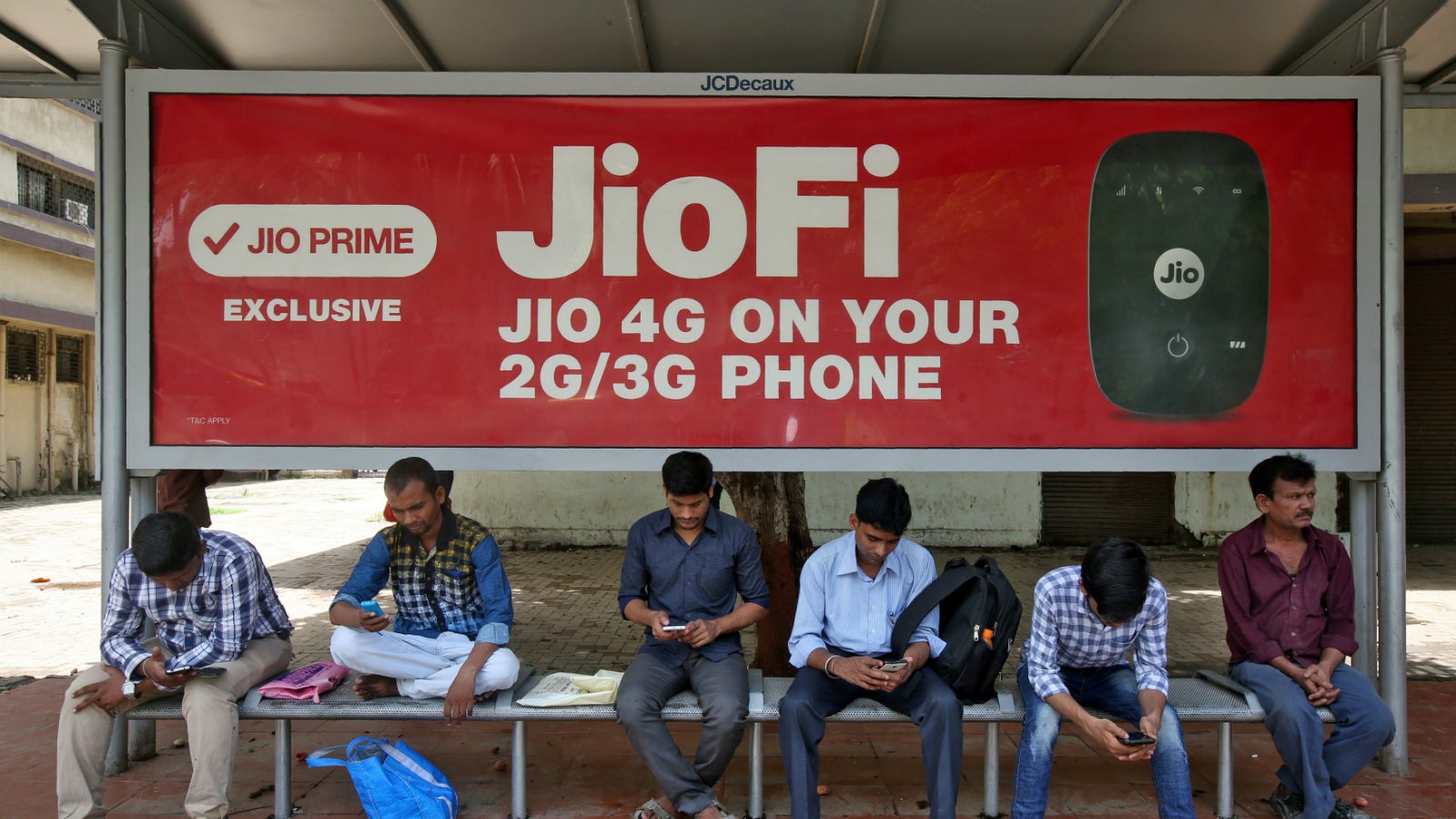For Quartz members—India’s answer to Amazon, AT&T, and Huawei
Hi [%first_name | Quartz member%],


Hi [%first_name | Quartz member%],
If tech giant CEOs were a high school clique, Mukesh Ambani would be its newest member—and everyone’s invited to a party at his house. India’s richest man, Ambani heads up conglomerate Reliance Industries, whose digital arm, Reliance Jio, is swiftly becoming India’s answer to Amazon, AT&T, and Huawei—all rolled into one. Today we’re looking at Reliance’s backstory (there’s a family feud!) and its future ambitions.
But first, a recap: The Dow broke up with Exxon this week, Ethiopia launched its second satellite, and the world’s most valuable company finally explained how much money it makes. Etsy is fighting with Amazon, and the US can’t keep dumbbells in stock. But hey, vinyl is back.
Your most-read story this week: A quirky passport design contest evokes Taiwan’s search for national identity. And most relatable member goes to whoever was researching Summer picnic recipes for mayonnaise haters. We get it.
Okay, close your eyes and dream big—bigger. Now you’re thinking like an Ambani.
Move over, Huawei
Founded in 1973 by Dhirubhai Ambani, Reliance Industries (RIL) cut its teeth on the oil business, before crushing its competition in India’s telecom sector. Now the company is eyeing India’s 5G market. Last month, Reliance confirmed plans to build its own 5G technology without help from Chinese companies, a development that would make Reliance Jio India’s first telecom firm with 5G capabilities.
Industry analysts back Reliance’s 5G claims, though a major chunk of their confidence comes from the company’s strong financial position—$87 billion in revenue—and the fact that Google paid $4.5 billion for a 7.7% stake in Jio Platforms (a wholly owned RIL subsidiary) last month. Google and Jio Platforms also plan to jointly develop an “entry-level affordable” 4G/5G smartphone.
Another mark in Reliance’s favor: a reputation for freebies and disruptive pricing. It’s expected that Jio’s 5G services would be 10-15% cheaper to roll out than competitors’, which will help it become a market leader in India. Plus, its China-proof tech will have international appeal.
To that end, Reliance couldn’t have better timing. India’s government has reportedly asked telecom firms to avoid using equipment from Chinese companies such as Huawei and ZTE, and the US, UK, and Australia have all banned Huawei from providing 5G equipment and technology in their countries. Jio would happily join Finland’s Nokia and Sweden’s Ericsson in the quest to fill that void.
“I encourage all countries to secure their communication networks by prohibiting untrusted vendors, thereby increasing the attractiveness of their digital infrastructure to outside investment,” US cyber diplomat Robert Strayer said in July. “Investors are more inclined to invest in countries that are secure from interference or disruption by vendors that could be subject to the control of authoritarian regimes.”
🍿 A history of Ambani drama
2002: Dhirubhai Ambani, who founded India’s Reliance Group with just $13, dies without a will in place. His elder son Mukesh becomes chairman and managing director of Reliance Industries. Younger son Anil is made vice-chairman.
2004: News of a property feud between the brothers surfaces for the first time in public. In a TV interview, Mukesh acknowledges the issue, but says it won’t affect Reliance’s business.
2005: The matriarch of the family, Kokilaben Ambani, intervenes to announce a demerger. The split approved by the board allows Mukesh to keep Reliance Industries and Indian Petrochemicals, while Anil gets Reliance Infocomm, Reliance Energy, and Reliance Capital.
2008: Anil files a defamation case against Mukesh over a New York Times interview in which Mukesh implies that Anil’s businesses oversaw shady information-gathering on India’s most powerful people.
2010: Anil withdraws the defamation case and claims the feud has been resolved.
2010: The two brothers scrap all existing “non-compete” agreements, allowing either group to enter sectors that had earlier been reserved for one of them.
2011: Mukesh and Anil come together to dedicate a memorial to their father. At the same event, Kokilaben tells the media that “there is love between the brothers,” signaling a reconciliation.
2013: The brothers sign a $200 million deal allowing them to run separate telecom companies that share networks to speed up 4G services.
2016: With a new venture—Reliance Jio—Mukesh formally enters the telecom sector.
2019: Thanks to Jio’s freebies and discounts, Reliance finds itself sitting on a $23 billion pile of net debt. Mukesh promises investors he’ll make the firm net-debt-free within 18 months.
January 2020: Jio becomes the biggest telecom operator in India by subscribers and revenue.
April 2020: Facebook buys a 9.99% stake in Jio Platforms for $5.7 billion.
June 2020: Reliance becomes debt-free, much earlier than its deadline of March 31, 2021.
July 2020: Google invests $4.5 billion for a 7.73% stake in Jio Platforms.
Name recognition
Reliance is the second-largest brand in the world after Apple, according to the FutureBrand Index 2020, a study that reorders PwC’s top 100 companies “by market capital dependent on sentiment quality and not based on monetary quality.” (Reliance ranks 91st on the PWC list.) Samsung comes in third on the FutureBrand Index, followed by Nvidia, Microsoft, and Nike.
Reliance’s reach
RIL has over 100 subsidiaries and eight listed firms, but most of its revenue comes from its retail arm, oil and petrochemical businesses, and telecom ventures. The last of those is ascendant: For the quarter ended June 30, RIL’s petrochem arm saw a 33% year-over-year decline in revenue, while revenue at its retail business dropped 17% in the same period. Jio, on the other hand, registered 182% growth.
👠 Reliance Retail:
- India’s largest retailer, with 11,000 stores and $19 billion in 2019 revenue.
- Partner brands include Diesel, Burberry, Gas, Hamleys, Giorgio Armani, Jimmy Choo, Muji, Michael Kors, Paul Smith, Satya Paul, and Tiffany’s, among others.
📱Reliance Jio (Jio for short):
- Includes wireless services, home broadband, and enterprise broadband.
- In 2019, RIL decided to reorganize its telecom and digital-facing business by setting up a wholly-owned subsidiary for digital platform initiatives, Jio Platforms.
- Jio Platforms include its telecom venture Reliance Jio Infocomm, with a user base of 400 million. Other services include JioTV, JioSaavn, JioMeet, JioHealthHub, and JioMart. All told, Indians can use Jio Platforms for everything from ordering groceries to making calls and handling payments.
- Recent investors in Jio Platforms include Facebook, Google, Silver Lake Partners, Vista Equity Partners, General Atlantic, KKR, Mubadala, and Abu Dhabi investment Authority.
💰 A short list of other sectors in which RIL has a presence: polymers, chemicals, polyesters, petroleum retail, textiles, new tech, healthcare, aerospace, media and entertainment, blockchain, education, and agriculture.
Quotable
“Every small business and entrepreneur has the potential in India to become Dhirubhai Ambani or Bill Gates. And that is the power that is what differentiates India from the rest of the world.” — Mukesh Ambani in an interview with Microsoft CEO Satya Nadella in February
While we’ve got you
Quartz is working on a field guide to the home office—and we want to see yours. Show off your setup by sending a high-resolution, horizontal JPEG to [email protected] for a chance to be featured in our upcoming guide. We particularly welcome creative setups in tight spaces.

Thanks for reading! And best wishes for an ambitious end to your week,
Niharika Sharma
Kira Bindrim